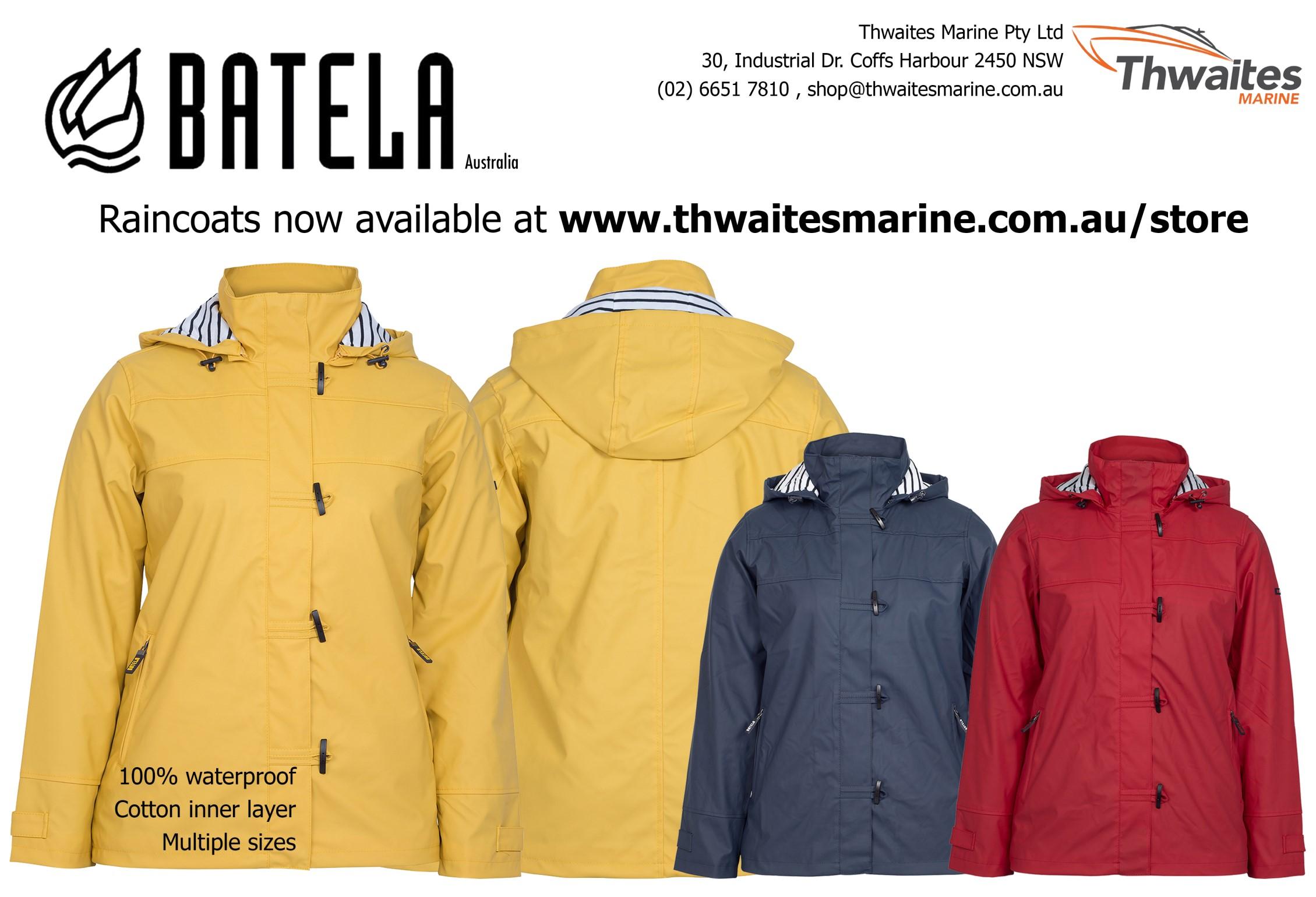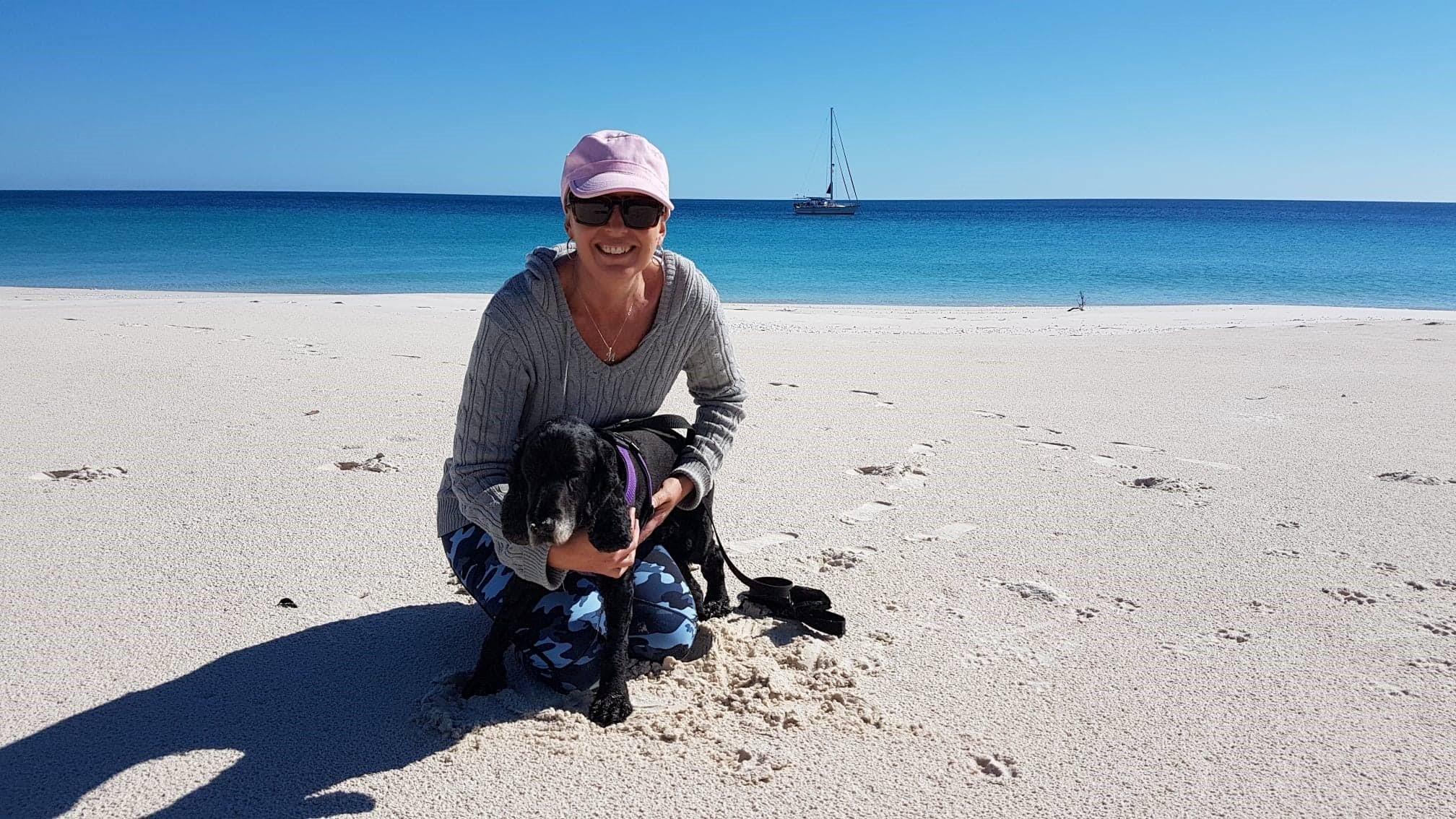
11 minute read
Dogs Who Sail: First Aid Kit
Tanya Rabe

Advertisement
Doggy First Aid Kits
You have one for yourself and your crew so why not have a First Aid Kit for Fido?
First Aid is help given to a sick or injured dog until full veterinarian treatment is available. On land, if our dog falls ill or is hurt, we have the luxury of jumping in the car and getting our dog to a vet relatively quickly. Our boats don’t travel as fast as a car and we may find ourselves hours, days, or even weeks from a veterinarian.
I encourage all boating dog owners who may find themselves in remote areas to gain a knowledge of basic First Aid for your dog and yourselves before you embark on your journey. There are many courses to choose from or books to read. It is much better to be prepared before an emergency happens.
In this article, I have prepared a list of items that we have used in our First Aid kit for our Cocker Spaniels Maxy and Mel. Our kit was put together with recommendations from local vets and our own research. Dogs Who Sail friend, Dr Sheridan Lathe from Vet Tails’ Sailing Chuffed has also taken a look over our kit and given it a thumbs up.

I am not a veterinarian and at no time am I giving you advice on what to medicate your dog with. It is your responsibility to visit your vet and have a lengthy conversation around such things as the health of your dog, what meds they will tolerate, when to use medications, dosage and for how long your canine friend should remain on them. Please don’t rely on Dr Google and social media to treat your best furry friend.
The Basics
Adhesive tapes A variety of bandages Cotton tips Cotton wool Eye wash Gauze and other wound dressings Glue Non-stick pads Scissors Thermometer
Anti-Diarrhoeal
If you haven’t experienced doggy diarrhoea on a boat yet, let me tell you, be armed for it when it does strike. Generally, you will need something a little stronger than your broadspectrum antibiotics to target the
inflammation of the large intestine. Maxy was diagnosed with the pesky little parasite, Giardia, in fact we were all treated for it after discovering our water tanks were in need of a good flushing and cleanse.
You will know when you need to administer this medicine. The causes of diarrhoea are relatively straight forward. Often there has usually been a change in the food you have been serving your dog or they have eaten something they shouldn’t have, causing an imbalance of the gastro-intestinal flora. Stress can be another factor that is behind diarrhoea.
It is helpful to feed a bland diet that is low in fat and high in carbohydrates, potatoes, pumpkin, pasta, white rice, and a little boiled chicken or turkey. Small amounts of natural yoghurt and cottage cheese that are low in fat are also nutritious options to be added to your dog’s meal.
If their poos are watery, ensure they have access to fresh, clean water as this means they are losing water and there’s a possibility they may become dehydrated.
Have clear instruction from your vet about at what point you give your dog the anti



Queen Elizabeth with torn paw pads from too much running (Stacey Newcomer). Pluto with broken toe in Bahamas (Annika Elias).
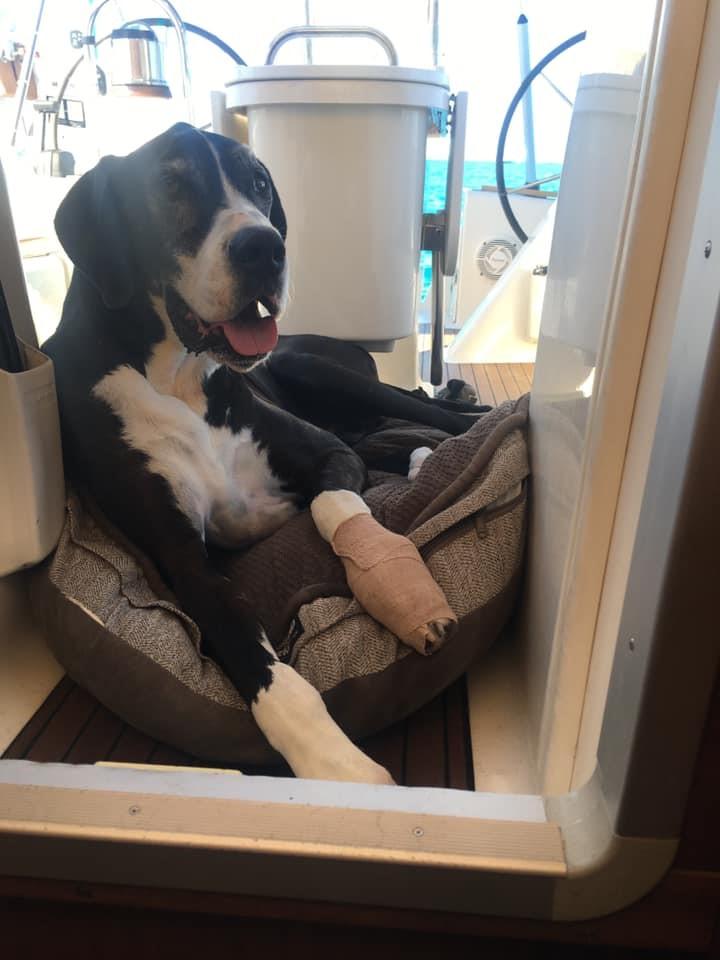

diarrhoeal medication.
Antibacterial Wash
There are specific doggy washes you can purchase from your vet or you can simply use something off the supermarket shelf. The antibacterial wash is used to clean wounds to safeguard from infections.
Antihistamine
Your vet may offer an antihistamine that can be given to your dog for any allergic reactions. Seasonal, food, environmental, and bites are most common allergies in dogs. The antihistamine eases swelling, inflammation, and irritation.
Apex Antibiotic Lotion
A broad-spectrum antifungal, antibacterial and anti-inflammatory cream used to treat dermatitis and eczema related infections.
Broad-Spectrum Antibiotic
A broad-spectrum bacterial antibiotic is used primarily for skin, periodontal and soft tissue infections (soft tissue being wounds,
abscesses, cellulitis etc). The last thing you want is for an infection to spread when it can be treated by medication. Yes, there is the argument around overuse of antibiotics but for the sake of your dog, have a supply of broad-spectrum antibiotics onboard and become knowledgeable as to when to use it by being guided by your vet’s advice.
Cerenia
This is an antiemetic which helps relieve your dog of vomiting and the prevention of vomiting caused by motion sickness.
Liquid Bandage Spray
This stuff is brilliant for dogs and for human. It’s no fuss application of spraying onto a clean, minor wound takes the fiddling out of wrapping a bandage wondering if it’s too loose, only to rewrap and wonder if it’s now too tight. Liquid bandages look and act like a second skin and they are created with compounds that allow the wound to breathe. The ingredients also promote healing and
INSET: Scrumpy after being attacked by two dogs in Grenada (Lynne Dorning Sands).




MAIN: Lucy’s rehab room (Tara Smith).
offer a waterproof seal and some even have a bitter tasting agent involved to stop Fido from licking the area. This is a great bandaging solution to keep a wound clean.
Not all wounds can be treated with a liquid bandage. Gaping wounds or lacerations, meaning cuts which go all of the way through the skin, should not have a liquid bandage applied. Instead you are considering the need for sutures or old-fashioned gauze and supportive bandaging until you are able to receive veterinarian attention.
Magnoplasm
This substance is a thick paste made from glycerol and magnesium sulphate which has the potential to draw out infections. This has

been used successfully for boils and also grass seed infections.
Metoclopramide
Is another antiemetic option that is also really common in humans, might be easier to obtain and have on board.
Muzzle
We know that our dogs would never intentionally hurt us but when they are in pain and we are trying to help them they may feel inclined to protect themselves by giving us a nip. Putting a muzzle on your furry crew member doesn’t mean they are a vicious dog. I have found the best muzzles are the soft ones with Velcro strapping. So very easy to pop on and off.
Neotopic –H
This is an antibiotic topical cream used to treat infections and skin conditions. It contains Hydrocortisone, Neomycin and Lignocaine. The Hydrocortisone eases the itch and swelling of skin irritations and the inflammation that comes with them. Neomycin is the antibiotic which will fight infection and Lignocaine offers effective pain relief.


Winston after two knee replacements (Ruthie Jones Lilly). Tilly on Morphine (Adam Nienkemper).


Numbing Agent –Anaesthetic
This may be a little challenging to get from your vet but if you have a long-term relationship, they may be happy to give you a script for this medication. Once again, this medication would only be administered in extreme medical emergencies when you may be required to suture a wound or splint a break.
Pain Relief and Antiinflammatory
Ask your veterinarian for something they would use for stronger pain such as postoperative pain and inflammation associated with soft tissue surgery. If Maxy and Mel are in excruciating pain from a broken bone or sting ray barb, I want something that is going to bring them some relief quickly.
Pheromone Spray
Scientists have managed to replicate the pheromones emitted by mother dogs to communicate with their puppies. It is the messages from these pheromones that helps the dog feel calm and peaceful, just as their mother would make them feel. A simple
Saline
Little tubes and pouches of saline are found in every First Aid kit and remain the go-to for flushing out wounds. Saline is defined as extremely diluted salt water. The salt has mild antiseptic properties while saline, when made to a specific recipe, has the same makeup as body tissue, tears, and blood and is gentle on essential healing cells.
The tubes often have a twist top or require a snip with scissors. Once opened apply liberally to wash the wound thoroughly. In some instances, you may use a syringe for a more precise cleanse.
Skin Stapler
An extension from sutures is the skin stapler. This is my preference for closing wounds. They are well known for their quicker application compared to traditional stitching, many brands claiming up to six times faster. The stapler is easier than making thread and needle sutures.
Due to its ease and speed of use, it is
Mac sporting his doughnut collar (Eden Oterholm).
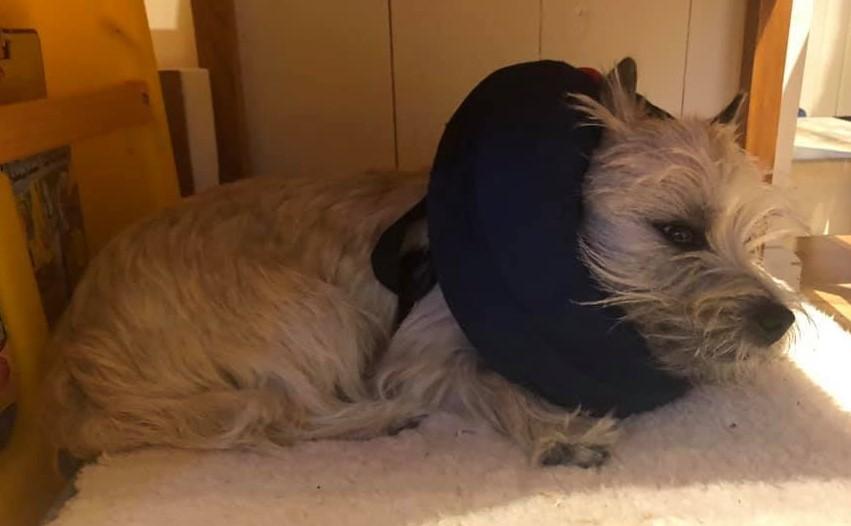

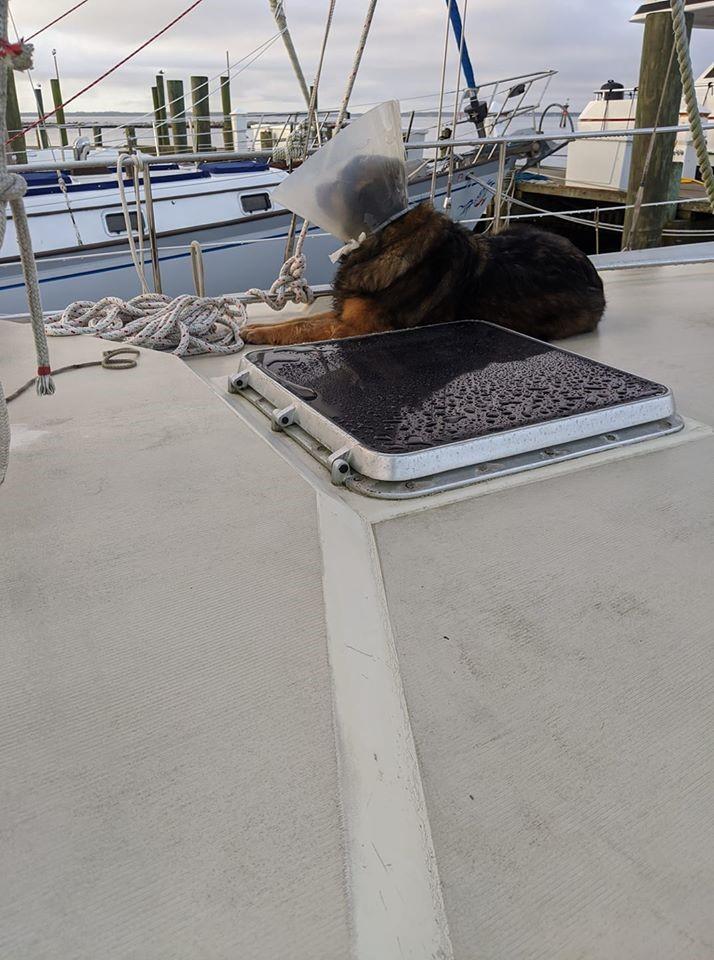
believed skin staplers are less painful for the dog. Just as you can buy suture kits you can also purchase staple gun kits. There are a variety of staple guns on the market, many offer a count feedback and some even give you confirmation of a successfully closed staple.
INSET: Cone of shame for licking her paw raw. Banished herself to the foredeck (Shawna Smith).




MAIN: Rover's Cone of Shame in the Bahamas (Caroline Spott).
As with conventional suturing, learn how to use the staple gun before you actually need to and know when to put the staples in and when to take them out. There are devices to assist with easy removal of the staples when the time comes.
Please don’t scrimp on an el-cheapo skin stapler. They are not expensive items, ranging from $10 to $30. The higher end of the scale will often include a staple remover.
Suture Kit
I pray to the God of Dogs that I never have to perform this procedure on Maxy or Mel, or any other dog for that matter but, if they were hurt and the wound needed closure, I would without a doubt, step in as their suture nurse.
In reality, suturing a conscious dog is going to be nigh on impossible, especially if you don’t have experience. I therefore do not recommend this procedure willingly. Instead, I will encourage you to talk to your vet about suturing or at the very least, take a look online at some videos from reputable sources to see how a suture is performed.
For some of us, this is hard to stomach, but in an emergency, you will be better equipped to deal with a serious wound having educated yourself prior to the event. The ultimate education is doing an Advanced First Aid certification which covers minor medical procedures.
The professional advice I have been given by vets is to ensure I have a skin stapler onboard.
A Word About the Cone of Shame
Last but not least I will include some thoughts around the Elizabethan Collar or ECollar. This is the big plastic cone that goes around your dog’s head to stop them from interfering with wounds.
In a recent discussion on Dogs Who Sail, a member brought up a good point. She was hesitant to use the big cone collar on her dog onboard because she feared if her dog fell overboard while wearing it, he would be a greater risk of drowning.
There are alternatives to this style of collar including surgical t-shirts for dogs and different collars which are less hazardous such a blow-up doughnut style or a poolnoodle necklace.
Whatever option you use, ensure your dog is always supervised when onboard.
Important Reminders
Always check used by dates of medicines.
Don’t use medication that your vet hasn’t advised you about.
TANYA RABE co-founded Dogs Who Sail with her two Cocker Spaniels Maxy and Mel. What began as a space to share their own story as liveaboards has now grown into a global community of dogs on boats. Tanya devotes her life to caring for dogs, celebrating their individuality and promoting responsible dog ownership. Ask to join Tanya’s closed Facebook group Dogs Who Sail. www.dogswhosail.com

